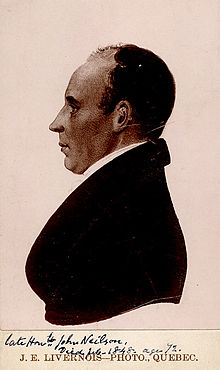John Neilson | |
|---|---|
 | |
| Member of the Legislative Assembly of Lower Canada, for Quebec County (two-member constituency) | |
| In office 1818 – 1834 (1 by-election and 4 general elections) Serving with
| |
| Preceded by | Pierre Brehaut |
| Succeeded by | Jean Blanchet |
| Member of the Legislative Council of Lower Canada | |
| In office August 22, 1837 – March 27, 1838 | |
| Member of the Special Council of Lower Canada | |
| In office April 2, 1838 – June 1, 1838 | |
| In office November 2, 1838 – February 10, 1841 | |
| Member of the Legislative Assembly of the Province of Canada for Quebec County | |
| In office 1841–1844 | |
| Preceded by | New position |
| Succeeded by | Pierre-Joseph-Olivier Chauveau |
| Member of the Legislative Council of the Province of Canada | |
| In office 1844–1848 | |
| Personal details | |
| Born | July 17, 1776 Balmaghie, Scotland |
| Died | February 1, 1848 (aged 71) Cap-Rouge, Province of Canada |
| Political party | Lower Canada: Parti canadien Province of Canada: Anti-unionist; French-Canadian Group |
| Spouse | Marie-Ursule Hubert |
| Relations | Thomas Lee (son-in-law) |
| Children | 10 |
| Occupation | Journalist; newspaper publisher; book printer and bookseller |
| Military service | |
| Allegiance | British Empire Lower Canada |
| Branch/service | Lower Canada militia |
| Rank | Lieutenant, 1824 |
John Neilson (July 17, 1776 – February 1, 1848) was a journalist, publisher and politician in Lower Canada (now Quebec). Born in Scotland, he emigrated to Lower Canada in 1791 at age 15, to work in his older brother's publishing company in Quebec City. On his brother's death a few years later, he inherited the business. Neilson became one of the leading publishers and booksellers in Lower Canada and in Upper Canada (now Ontario), selling books in both French and English. He was the editor of the newspaper La Gazette de Québec / The Quebec Gazette, published in French and in English.
Once well-established financially, Neilson entered politics. Elected to the Legislative Assembly of Lower Canada as a supporter of the Parti canadien, he became a strong opponent to the provincial government under the governors appointed by the British government. He argued for greater control of the provincial government by the elected Legislative Assembly of Lower Canada. In 1823, he and Louis-Joseph Papineau travelled to London to argue against a proposal to merge Lower Canada with Upper Canada. In 1828, he was part of another delegation to London, to make submissions criticizing the financial controls of the governors. Although an ally of some of the leading French-Canadian politicians, such as Papineau, he gradually split with them as they became increasingly more radical during the 1830s. He opposed the Lower Canada Rebellion which broke out in 1837.
The result of the rebellion was that the two provinces were merged into a single province, the Province of Canada. In 1841, Neilson was elected to the Legislative Assembly of the new Parliament of the Province of Canada, where he opposed the union. He was defeated in the general election of 1844, but then was named by the governor to the Legislative Council, the appointed upper house of the Parliament. He held that position for the rest of his life.